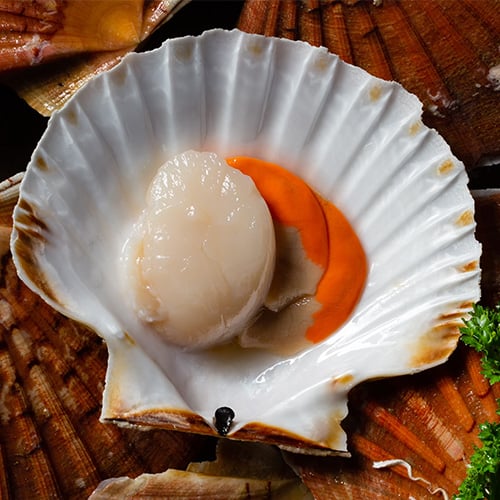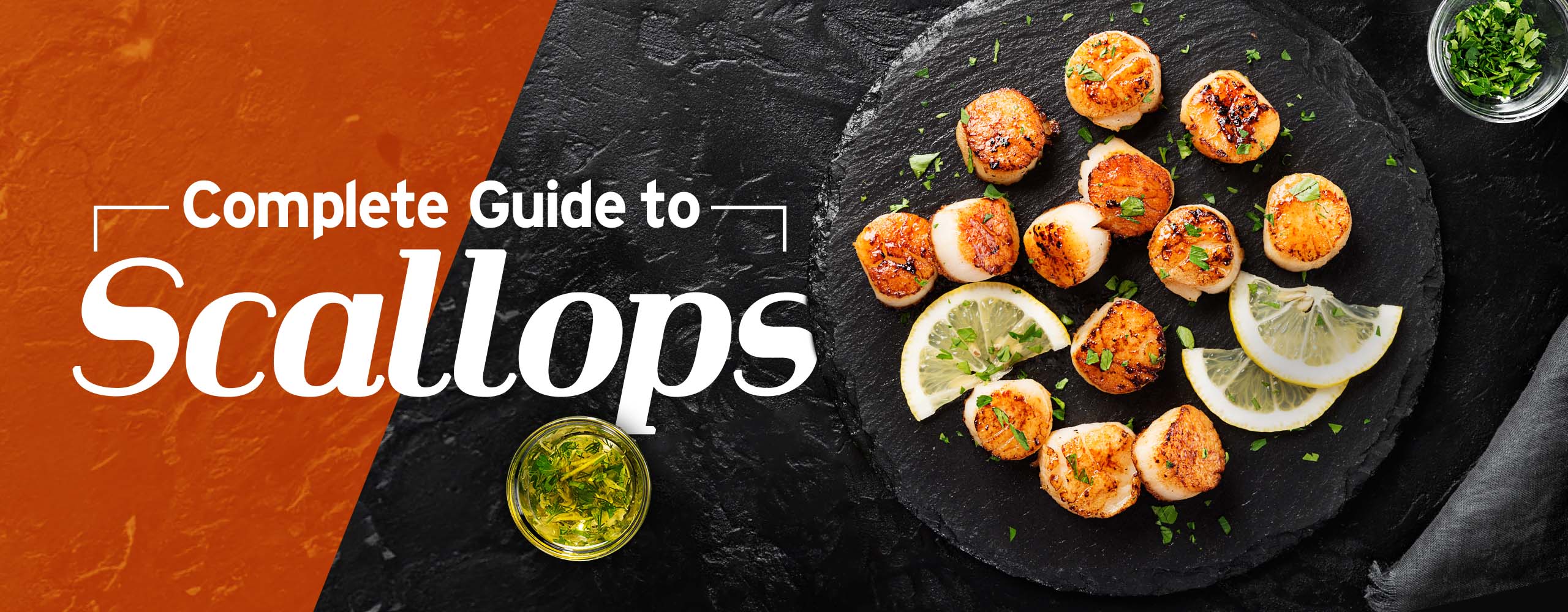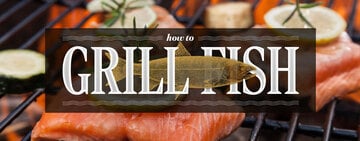The Complete Guide to Scallops
Last updated on Aug 24, 2023Michale LeRoyScallops are a type of mollusk that can be found in oceans all around the world. They are known for their delicious flavor and tender texture, which makes them a popular choice in many different types of cuisine. Easy to prepare, scallops are a convenient option you can use to expand your seafood menu. Keep reading to learn all about scallops, where they come from, and how to prepare them.
What Are Scallops?

Scallops are bivalve mollusks, which means they are a type of shellfish with two shells that are hinged together. When the scallop opens its shell, you can see the fleshy part of the animal inside. This is the part that we eat! The interior muscle of a scallop can range in color from white to pink or even orange. When cooked, the muscle becomes round and tender, making it a favorite among seafood lovers.
Scallops are also known for their impressive swimming abilities. Using their powerful adductor muscles, scallops can propel themselves through the water by opening and closing their shells.
What Do Scallops Taste Like?
Scallops have a mild, sweet, and slightly briny taste. When cooked, they are tender and buttery. They don’t have a strong taste like their cousins, clams and oysters. Sometimes their delicate flavor is compared to lobster or types of crab. This makes them an extremely popular option for those who don't normally enjoy seafood.
What Do Scallops Look Like?
Scallops are easy to recognize, thanks to their distinctive shell. They have a symmetrical, fan-like shape with a scalloped edge and a bottom hinge. Scallop shells come in a range of colors, from pale white or beige to shades of pink or orange. Some scallops even have a slightly iridescent shimmer to their shells.
Where Do Scallops Come From?

Bay scallops, which are smaller and sweeter than sea scallops, are found in bays, estuaries, and shallow waters along the East Coast. These scallops live in sandy bottoms and can be found from New England down to the Gulf of Mexico. While they are harvested by hand in some areas, many are now farmed.
Sea scallops, on the other hand, are found in cold, deep ocean waters. These larger scallops are typically found off the coast of New England and Canada, as well as in the waters around Iceland and Norway.
When Is Scallop Season?
Scallop season occurs in the late fall and winter months when the water is cooler and scallops are at their peak. During this time, scallops are harvested and shipped out to restaurants and seafood markets across the country.
However, just because scallop season is limited to a few months out of the year doesn't mean you can't enjoy them year-round. Frozen scallops are available year-round and can be just as delicious as fresh scallops when prepared correctly. In fact, many chefs prefer to use frozen scallops because they are easier to work with and have a longer shelf life.
Types of Scallops
Scallops are categorized in several different ways depending on where and how they are harvested. Learn more about the types of scallops below:
Bay Scallops vs Sea Scallops

There are two main types of scallops - bay scallops and sea scallops. While they may look similar at first glance, there are a few key differences that set them apart. Bay scallops are smaller in size compared to their sea scallop counterparts, measuring in at around 1 inch in diameter. They are found in estuaries and shallow waters, which contributes to their smaller size. On the other hand, sea scallops are much larger, measuring in at around 2 inches across. They are often found in deep ocean waters, which allows them to grow to a much larger size than bay scallops.
While both types of scallops are delicious and versatile in the kitchen, they do have slightly different applications. Bay scallops are often used in dishes where their small size is an advantage, such as in pasta dishes or as a topping for salads. Sea scallops, with their larger size, are often used as a standalone entree or in dishes where their size won't be an issue.
Diver Scallops
Diver scallops are handpicked from the ocean floor by skilled divers. This means they are not harvested by bottom trawlers, which can damage the ocean floor and result in bycatch. One of the things that set diver scallops apart is their slightly larger size. This makes them a great choice for recipes that call for larger scallops. Because they are handpicked, they are minimally damaged, which can affect their texture and taste.
Dayboat Scallops
Dayboat scallops are the more common type of scallops you'll find on the market because they are harvested on a larger scale than diver scallops. Unlike diver scallops, which are individually hand-harvested by divers, dayboat scallops are caught using chain drag nets. While this method may not be as selective as hand-diving, it allows for larger quantities of scallops to be harvested at once.
Wet Scallops vs Dry Scallops
When you see scallops labeled as “wet” or “dry”, this refers to their packaging. Dry scallops, also known as natural scallops, are untreated and chemical-free. They are packaged immediately after being shucked. Dry scallops have a slightly sweet and briny flavor, and they are often preferred by chefs for their purity and natural taste.
After shucking, wet scallops are treated with a preservative called sodium triphosphate. This additive helps the scallops retain moisture and increases their weight, making them more profitable for distributors. However, the downside is that the sodium triphosphate can give wet scallops a slightly soapy flavor and a rubbery texture.
If you're looking for the purest and most natural scallop flavor, dry scallops are the way to go. But if you're working with a tighter budget or need to increase the weight of your scallops, wet scallops may be a better option.
Scallop Sizes
When it comes to cooking with scallops, size matters. Scallops are sized by the number of pieces per pound. The smaller the number, the larger the scallop. U10 means that there are under 10 scallops in a pound, while U40 means there are about 40 scallops in a pound. If you're looking to sear scallops, larger scallops will take longer to cook. On the other hand, if you're making a scallop ceviche, you may want to use smaller scallops for a more delicate texture.
This is a general size guide you can use to purchase scallops:
- U8 Scallops - Under 8 scallops per pound (2 1/2" to 2 3/4" diameter)
- U10 Scallops - Under 10 scallops per pound (2 1/2" diameter)
- U12 Scallops - Under 12 scallops per pound (2 1/4" to 2 1/2" diameter)
- U10/20 Scallops - 10 to 20 scallops per pound (2" diameter)
- U30/40 Scallops - 30 to 40 scallops per pound (1 1/2" to 1 3/4" diameter)
- U40/60 Scallops - 40 to 60 scallops per pound (1" to 1 1/2" diameter)
- U60/80 Scallops - 60 to 80 scallops per pound (1” diameter or less)
How to Buy Scallops

It's important to know what to look for when buying scallops so you get a safe, consistent product. First and foremost, avoid fresh scallops that are discolored. This is a sign that the scallops have been sitting in storage for too long.
Look for scallops that are plump and have a fresh, briny smell. They should be a creamy, off-white color and have a firm texture. If you're buying fresh scallops, try to purchase them the same day you plan on cooking them to ensure maximum freshness.
If you're buying frozen scallops, make sure they don’t have ice crystals. This is an indicator they may have thawed in storage. Scallops that have been thawed and refrozen can become mushy and lose their flavor.
How to Store Scallops
Proper storage of scallops is essential to food safety and to maintain their quality and freshness. Here's what you need to know about storing scallops:
- Keep them cold - Scallops are considered a TCS food, so they need to be received at 40 degrees or below. If you have fresh scallops that you won't be using within a day or two, you can also freeze them.
- Use airtight containers - When storing scallops in the refrigerator, make sure to use an airtight container or a resealable plastic bag to prevent the scallops from drying out or absorbing unwanted flavors.
- Don't store them for too long - Depending on the freshness of the scallops, they can be stored in the refrigerator for up to two days. If you're not sure how fresh your scallops are, it's best to use them within a day of purchasing them.
- Check for any signs of spoilage - Before cooking scallops, always check them for any signs of spoilage, such as a strong odor, slimy texture, or discoloration. If you notice any of these signs, discard the scallops immediately.
How to Cook Scallops

There are several ways to cook scallops, but one of the most popular cooking methods is by searing them. This involves cooking them quickly over high heat in a pan, which creates a nice crust on the outside while keeping the inside tender and juicy.
To sear scallops, start by heating a pan over medium-high heat. Add a bit of oil or butter to the pan and let it get hot. Pat the scallops dry with a paper towel and season them with salt and pepper. Then, carefully add them to the pan, making sure they are not touching each other. Let them cook for about 1-2 minutes on each side, or until they are golden brown and cooked through. Scallops cook very quickly, which makes them ideal for your seafood menu.
Can You Cook Frozen Scallops?
We recommend using a food-safe thawing method before cooking your scallops. Cooking frozen scallops is possible, but it won't result in the best texture. Also, more liquid is released from a frozen scallop which isn't ideal for searing.
Scallops FAQ
If you're still looking for answers, we cover some frequently asked questions about scallops below:
Are Scallops Shellfish?
Yes, scallops are a type of shellfish that belong to the mollusk family, which includes clams, oysters, and mussels. Similar to other shellfish, scallops have a hard outer shell that protects their soft and delicate insides. However, unlike other shellfish, scallops can swim by rapidly opening and closing their shells, which allows them to move through the water quickly.
Are Scallops Sustainable?
Yes, many types of scallops are considered a sustainable seafood option according to Seafood Watch. Scallops are filter feeders, meaning they don't require any additional food or resources to grow. This makes them a low-impact seafood choice. But, not all scallop fisheries are created equal. Some scallop fisheries have been known to create negative impacts on the surrounding environment. That's why it's important to look for scallops that are certified sustainable by organizations like the Marine Stewardship Council or Seafood Watch.
Can You Eat Scallops Raw?
Yes, but it's important to ensure that scallops are fresh and handled properly before serving them raw to your customers. Raw scallops are a popular ingredient in dishes such as sashimi, ceviche, or carpaccio. Always purchase scallops from a reputable seafood seller and keep them refrigerated until ready to use. Inspect shipments carefully and if the scallops have a strong fishy odor or slimy texture, do not accept the delivery.
With their delicious flavor and versatile nature, scallops make an easy addition to your menu. They can be used in a variety of dishes, including scallop ceviche, scallop risotto, and even scallop tacos. Thanks to their creamy, mild taste and delicate texture, scallops have a wide appeal, even with customers who don't normally order seafood.



